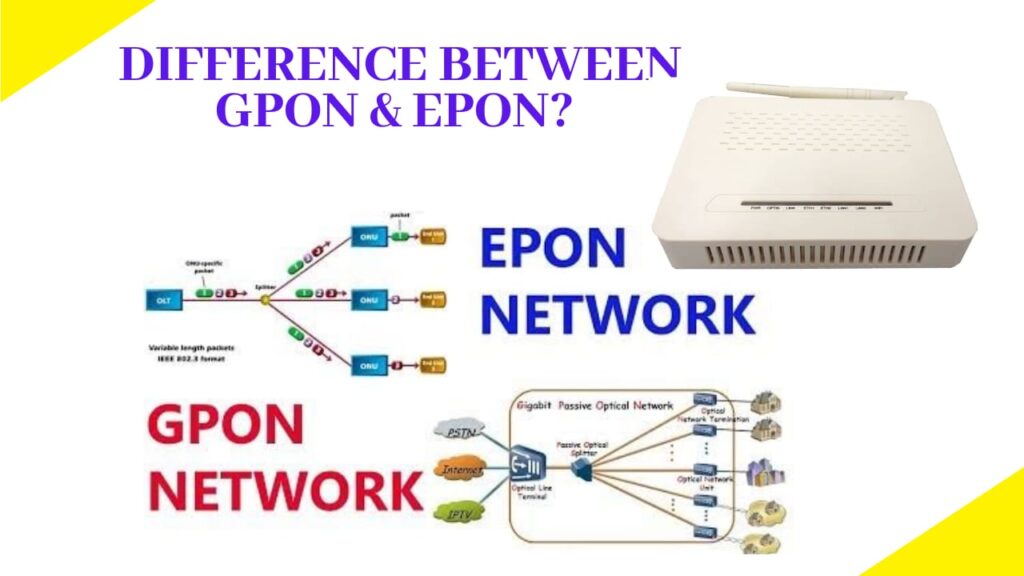
GPON vs EPON: Difference between GPON and EPON
Have you ever come across the terms GPON and EPON? If yes, do you know the differences between GPON and EPON(GPON vs EPON)? If not, let’s discuss some of the important things related to them that you need to know.
GPON refers to Gigabit Passive Optical Network and EPON refers to Ethernet Passive Optical Network. Both GPON and EPON belong to the Passive Optical Network (PON). It is a fiber network therefore, instead of using active components like amplifiers, repeaters, and shaping circuits it uses only fiber and passive elements like splitters and combiners.
Passive Optical Network has the advantage of wavelength division multiplexing (WDM). It uses one wavelength for downstream traffic and another for upstream traffic on single-mode fiber. BPON, GPON, and GEPON have the same basic wavelength plan. It uses 1490 nm wavelength for downstream traffic and 1310 nm wavelength for upstream traffic.
What is GPON?
GPON (Gigabit Passive Optical Network) is based on the TU-TG.984.x standard for new generations of broadband passive optical access. It provides its user’s unprecedented high bandwidth downlink rate of up to 2.5 Gbit/s, an asymmetric feature better adapted to the broadband data services market.
GPON also gives Access Network Level Protection Mechanism and full OAM functions. It is widely deployed in the FTTH network. It can also develop into two directions which are 10 GPON and WDM-PON.
What is EPON?
EPON (Ethernet Passive Optical Network) opposite to GPON uses Ethernet packets instead of ATM cells. It’s a high-speed Ethernet over PONs that are pointed to multipoint to the premises (FTTP) or FTTH architecture. EPON can develop broadband access technologies through a single fiber-optic access method to obtain data, voice, and video services.
Read more: What is a PLC Splitter and How Does a PLC Splitter Work?
Difference Between GPON and EPON (GPON vs EPON)
GPON offers its users three Layer and two networks – ATM for voice, Ethernet for data, and proprietary encapsulation for voice. EPON on the other hand employs a single Layer two network that uses IP to carry data, voice, and video.
For more information, let’s use a table to compare GPON vs EPON
| GPON | EPON |
| GPON provides L2 dynamic rerouting | EPON does not offer L2 dynamic rerouting |
| GPON has POE 30W/port | EPON has no POE 30W/port |
| GPON has IPVG | EPON has no IPVG |
| GPON has a reach of 128 ONUs | EPON has reach a of 32 ONUs per OLT or 64 FEC |
| GPON per-subscriber cost is higher | While EPON, on the other hand, has lower per-subscriber cost |
| GPON does not support multicast services | EPON, on the other hand, supports a single management system |
| GPON supports only downstream encryption | EPON supports both downstream and upstream encryption |
| GPON usable bandwidth for downstream is 1.25 Gbit/s or 2.5 Gbit/s upstream 155 Mbit/s 2.5 Gbit/s | EPON usable bandwidth is 1 Gbit/s symmetrical bandwidth |
To Sum Up
PON is an important technology to carry over broadband access network services. Both GPON and EPON have their own use and benefits. However, Epon has the benefit of time and cost, GPON is more suitable for customers with high bandwidth, multi-services, QoS, security requirements, and ATM technology as its backbone.
Therefore, it’s better you decide on your own depending on your needs and demands.
We hope this blog appeared useful and guided you with relative information about GPON and EPON and their differences.
If you have any doubts or queries, feel free to contact us.

